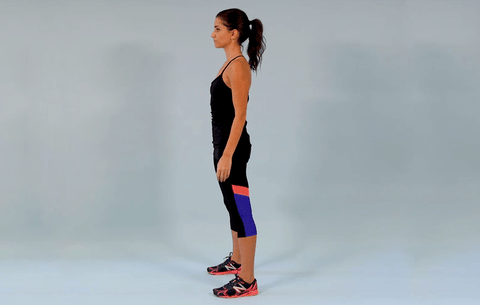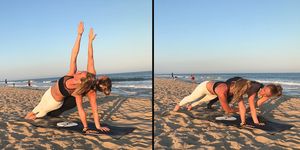
Last winter, I spent some time in Los Angeles, and was thrilled at the opp to kick off my boots and go for short run on the beach. But less than two miles in, my legs were WAY more tired than I anticipated, my feet started burning (turns out the sand was creating some major blisters), and I wasn’t even close to my mileage goal—I ended up hobbling back to my car in shame…such a rookie mistake.
That’s not to say you shouldn’t run on the beach—but you should know what you’re getting yourself into before you do.
“As beautiful as a beach run may sound, it’s far more challenging than we like to think, says Jess Movold, a running coach at Mile High Run Club in New York City, “which makes a beach run an incredible workout to add into your summer routine. With added resistance from the sand, your heart rate rises faster and your muscles have to work harder.”
So before you give up the pavement for the sand, take note of Movold’s must-know tips.
1. Really Warm Up Your Legs
Running on the beach is going to work your leg muscles harder than the pavement, so it’s even more important that you make time for a dynamic warm-up that targets your posterior chain—that means: forward lunges, hip circles, high knees, and butt kickers, says Movold. And with the uneven terrain, you’re going to want to prep your ankles. “Do some seated ankle rotations in both directions; calf raises to wake up the arches in your feet,”
Body weight squats are also great to work on your range of motion, activate the glutes, and open up the hip flexors, adds Movold. Here’s how to do them with proper form:


Jenn Pena
2. Slow Down Your Pace
It’s so exciting and gorgeous to run alongside the ocean, but don’t think that exhilaration is going to boost your speed. “Running the ‘average’ speed you’re used to running on a road will feel unbearable once you try that pace on the sand,” says Movold. “The change of terrain and lesser impact of the sand will make it feel like you’re strapping ankle weights to your legs.”
Don’t stress about the pace on your fitness tracker; just enjoy the views. If you do want to incorporate speed, “do so by operating in a mode of perceived exertion,” Movold says. “Find a speed that feels like 85 percent exertion, knowing it will be significantly lower than a pace you would keep on a harder surface.”
3. Plan on Running for Time, Not Distance



It’s great to go out for a run and say: “Hey, I’m going to log 3 miles today, let’s go!” The beach is not the place for that. The sand itself makes your hip- and knee-stabilizing muscles work twice as hard, a study published in the European Journal of Applied Physiology found. And running on sand requires 1.6 times as much energy expenditure as running on a firmer surface, according to a study published in The Journal of Experimental Biology.
That all means three miles might feel like 13, which could set you up for disappointment if you don’t meet your mileage. Set a realistic time goal instead.
4. Remember: Not All Sand Is Created Equal
Maybe you love running in the soft, warm sand; maybe you prefer the damp, packed sand by the ocean. Both have benefits, and you should try running on both parts of the beach. “The softer the sand, the more challenging your run becomes,” says Movold. “Start on the harder, wet sand to build tolerance to the resistance and difficulty, then you can progress to the softer sand as those little muscles in your feet get stronger.”
Try the “Zig-Zag” beach workout to acclimate:
If you’re more injury-prone, though, stick to the soft sand; you’ll experience less muscle damage and inflammation than running on a harder surface, according to study published in the European Journal of Sport Science, and less muscle soreness and fatigue, research published in the Journal of Sports Sciences says.
5. Mind the Slope
The slant and angle of the beach have a major effect on your body when you run. “If you’re going in one direction, one leg won’t be as fully extended and will be taking more impact on the knee and hip than the other side,” says Movold. “Even out the disconnect by changing directions for half of your run.” Start with 10 minutes in one direction, then 10 in the other direction; you can add on time as your comfort level increases.
6. Keep Your Shoes On—At Least At First
Wearing shoes on the beach might seem counterintuitive—aren’t you here to shed those sneakers and feel your toes dig into the sand?! Well, according to Movold: “It’s important to start your beach running journey with shoes on. This will give you some ankle support and stability before going full-throttle barefoot running.”
Since your shoes provide ankle stabilization and general foot support, running without them plus running on a new terrain could prove too much for your feet on your first go (*ahem*, remember my experience?). “On your second day of beach running, you can go for no shoes, spending time on the harder sand before moving into the softer,” Movold says.
7. Add on Time Gradually
“The muscles in our lower legs and especially the feet are working twice as hard on a beach run than on pavement,” says Movold. In fact, your body is still working 10 percent harder on the sand than it does on grass, according to a study published in the Journal of Strength and Conditioning Research.

“Because of the overuse of shoes in our daily lives, the intrinsic muscles in our feet have become de-conditioned,” says Movold. “So beach running should be done conservatively to gradually build those stronger small foot muscles that are doing more work than they’re used to.”
8. Keep It to Three Times a Week
If you’re a regular runner racking up miles, you don’t want to do them all on the beach—and if you’re new to it, even one day a week is fine. “Beach running is a significant workout!” says Movold. “Take a day in between for recovery until you feel ready to add an additional day into your workout routine.”
Source: Read Full Article
